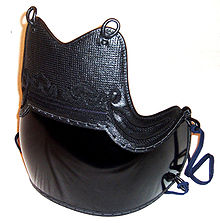Dō (Kendō)
The Dō [ doː ] ( Japanese ) is the breastplate of the Kendō armor ( Bōgu ). Its shape is based on the chest protector of the samurai armor . Dō is also the general Japanese term for the breastplate of armor.
history
Between 1750 and 1770, the classic sword fighting exercises - with katana or bokutō - were joined by bamboo shinai and increasingly pieces of armor. After Shinai and Kote , the Dō was added, the development of which is attributed to Chuta Nakanishi, the founder of the Nakanashi Itto-ryu. It was followed by the Tare and Men to, Bogu to complete.
construction
The Dō consists of two parts:
Mune
The mune (Japanese 胸 - chest ) protects the chest from bumps and blows. Today it is no longer an official hit area in modern Kendô, but in the past kicks (tsuki) to the mune were considered hits. In Gekiken, which is still being trained in some Kenjutsu schools, this hit area is still permitted. It consists of an inner lining made of wool or similar materials and two outer layers of cowhide. Traditionally, the mune is dyed black and partly with elaborate embroidery. The leather loops attached to the upper edge are called Mune-chichi-kawa .
Do-dai
The do-dai is sewn onto the lower edge of the mune . It traditionally consists of 43 to 64 bamboo struts. The outside is covered with leather . This can be simple cow leather, but shark or stingray leather is also used. The inside is often painted red, the outside black. There may be a leather loop for hanging in the dō. Today's do-dai are often made of plastic or fiberglass , but bamboo is considered a more suitable material due to its better shock-absorbing properties. The four leather loops on the side of the Do-dai are called Do-chichi-kawa . Two cotton straps crossed at the back ( Japanese , 紐 - Himo) hold the doo with the help of leather loops on the upper body. Often a mon (Japanese 紋, sign or emblem) is attached to the do-dai . This coat of arms can refer to the club, school, university or family today.
Creation of the do
The do is put on as the second piece of armor after the tare in the Seiza sitting position :
- Hold the do in front of your chest so that the upper leather loops are at collarbone height.
- Guide the left of the upper (longer) Himo across your back to the loop on your right collarbone and fasten it. Do the same with the right Himo.
- Tie the lower (short) Himo with a bow behind the back.
Do as a hit area
The doo is one of the hit surfaces in kendo . The blows are performed laterally on the right (migi-do) or left (hidari-do) below the armpits at about the angle of the ribs running there. The Kiai is “ Dō! “Called.
literature
- John Donohue: Complete Kendo. Tuttle Publishing, Boston MA 1999, ISBN 0-8048-3148-3 , p. 23.
